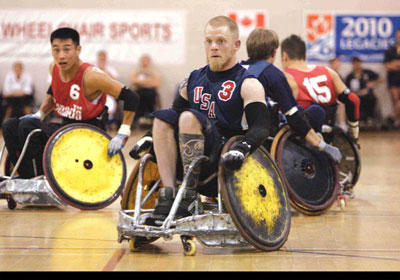
I just got home from a screening of Murderball, a documentary that opened in the United States last week and opens in Canada in just a few days — and I really, really liked it.
There are a number of subtextual ironies wrapped up just in the film’s name. For one thing, “Murderball” is the name that quadriplegic rugby, or wheelchair rugby, apparently had when it was invented in Winnipeg almost 30 years ago — by a man who now lives in Vancouver, in fact — but the sport has acquired a more polite and politically correct name now that it has spread to other countries; one athlete interviewed in this film quips that the name change was designed to make the sport more palatable to corporate sponsors, though it is not clear that corporations have signed on in significant numbers just yet. The film, on the other hand, puts the game’s original in-your-face name right there in the title, and it’s doubtful the film — which will probably do more to raise the game’s profile than any other single initiative — would be anywhere near as successful if it were called “Quad Rugby”.
For another, the film can afford to be so in-your-face because, although the sport was invented in Canada, the film is about Team USA, and we all know how aggressiveness and competitiveness are celebrated in American culture but shunned in Canadian culture. And what is the film’s central narrative? The rivalry between the American team and an American athlete who was so competitive that, when he could no longer play for them, he became the coach of the Canadian team just so that he could get back at them!
Alas, as far as this film is concerned, the Canadians are merely accessories to their coach, Joe Soares, and they are never treated liked individual characters; and it is the American team’s members who are fleshed out properly, with girlfriends and parents and high-school buddies and whatnot. But this is, after all, an American film, so that seems fair enough. And the characters who populate this film are certainly an interesting bunch.
For example, it is intriguing to see how Soares, whose family came to the States from Portugal when he was 11, considers his success a tribute to the “American dream”, even as his former teammates accuse him of “betraying” his country by coaching the Canadians. It is also interesting to see how obsessed Soares can be with his sport, in a way that seems to marginalize his wife and brainy son, whose lack of interest in athletics is a bit of a letdown to stern old dad; in one scene, Soares goes out for dinner with his wife on their wedding anniversary, and when she toasts him, “To you,” he replies, “To Team Canada, hopefully.” Soares’s personal story takes an interesting turn about halfway through the film, incidentally — a turn that evokes the closest thing this film has to religious language — but I won’t spoil that here. (And speaking of religious language, it was interesting to see this film about athletically inclined quadriplegics so soon after re-watching Joni.)
There’s a lot more I could talk about — the former intern at the morgue who misses her job because she misses “the people”, the child who wonders how a remarkably dextrous quad with no hands handles his pizza, the grown-ups who wonder if the men can still function sexually, the bizarre and semi-graphic informational video that teaches quadriplegics how to function sexually, and so on — but it’s better if you experience the film for yourself.
I will say, though, that I appreciated the epilogue, in which these athletes — mostly men in their late 20s or 30s who lost the use of their limbs to disease and accidents some years ago — visit a group of Iraq War veterans who seem to be so much younger yet have lost their limbs in situations that were presumably much more serious. There is nothing particularly political about the way this coda is filmed or edited together, and the scene is of a piece with other scenes in which the athletes visit and inspire people who are just beginning to get used to their quadriplegic situation; but it’s still a remarkably poignant note on which to end this film.
FWIW, the screening was followed by a Q&A; with Ian Chan that was nearly as interesting and entertaining as the film itself. Also, check out the cover story in this week’s Georgia Straight.












